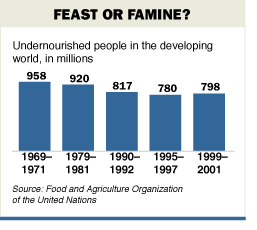
Dynamics

|
Generational Dynamics |
| Forecasting America's Destiny ... and the World's | |
| HOME WEB LOG COUNTRY WIKI COMMENT FORUM DOWNLOADS ABOUT | |
I've been using the phrase "Malthus Effect" as a name to describe the phenomenon that the population grows faster than food production.
In a book called An Essay on the Principle of Population published in England in 1798, Thomas Roberts Malthus concluded that population grows faster than food production, and that therefore famines can't be avoided.
Some politicians make the claim that Malthus' predictions have proven untrue, a claim that I consider bizarre when you consider that you can pick any day of any year and there are 20-40 wars going on in the world.
My own rough estimate is that food production grows by 0.96% per year, while population growth exceeds 1.25% per year, and is 2-4% in some countries. (However, the United States population has been growing around 0.92% per year.)
[Correction: UN figures show that population growth has been 1.72% since 1950, not 1.25%.]
 |
An article in Friday's Wall Street Journal (28-Jun) shows that what's happening is that food production grew faster than the population starting in the mid-1960s, but even so, the number of hungry or undernourished people has been increasing since 1997.
How do all these figures relate to each other?
The reason that food production grew so fast for 30 years is because of the "Green Revolution" that began in 1948 in Mexico and really exploded in India in the 1960s. It involved bringing new, hi tech agricultural techniques to underdeveloped countries, resulting in a big spurt in food production, much faster than the 0.96% that I estimated.
But that was a "one-shot deal." Once all the major farmlands of the world have been brought to the state of the art, then the 0.96% rate kicks in again.
The 0.96% figure is a rough estimate of mine. I wanted to get a kind
of "steady state" figure for the rate of increase of food production
that would be independent of things like the green revolution. So I
went to the USDA statistical service
The "Feast or Famine" graphic above shows what happened. The Green Revolution reduced hunger around the world until 1997, but then the population started growing faster than food production again. Thus, the Malthus Effect is back with a vengeance.
What is the consequence of the Malthus Effect? Most people think that the principle result is famine, but that's wrong. Of course there are occasional famines, such as the mass genocide by famine currently taking place in the Darfur region of Sudan. It will probably cost millions of lives before the winter is over.
But the most important consequence of the Malthus Effect is war. Thanks to the Malthus Effect, food becomes continually more expensive which, in turns, drives larger and larger populations into poverty, and that forces populations into war to survive.
 |
It's amazing how grotesque poverty can be, as the adjacent picture, taken recently in Haiti, shows. This kind of poverty is is caused by the Malthus Effect. As food becomes more expensive, people have no money to pay for other things, such as repairing their homes or even collecting the garbage from the street. Scenes like this occur around the developing world, and there are more of them each month, as the price of food continues to increase.
The "Feast or Famine" graphic above only goes through 2001, but it's fairly certain that the problem has gotten much worse in the last 12 months. The reason is that China has been buying up food at a much greater rate in the last year to feed its blistering economy. Have you noticed the increase in food prices at your local supermarket? A lot of that is because of China's substantially increased demand for food.
Africa and Asia have been hard-hit by the food price increases for another reason: AIDS. Fighting AIDS costs a great deal of money, and when you have to spend money on AIDS, then you have less money to spend on food, and if the price of food is going up, then you can't afford to buy much food at all.
As if that isn't enough bad news, there's more. When you're fighting AIDS, and you're an agricultural economy, then you also can't afford to buy seeds to plant for crops. So southern African countries like Lesotho, Malawi, Mozambique, Swaziland, Zambia and Zimbabwe are being hit by famine. These countries used to be able to feed themselves and even export food, but now they're being hit by a perfect storm: money goes first for AIDS, then for food, and if there's any left it goes for seeds. Agricultural production is way down, and these countries are now starving.
(Here's a political note: Remember that big brouhaha over genetically modified food a couple of years ago? America wanted to ship it to Africa, but were prevented from doing so by the EU? Well, the EU has been softening its stand in view of the African famine.)
This is a problem that gets worse every year, every month, every day, every minute, as the population continually grows faster than the food supply. And being the curmudgeon that I am, it falls to me to point out that there's one and one solution: a war large enough to thin the population. If you don't believe that Generational Dynamics proves that a "clash of civilizations" world war is inevitable, then the Malthus Effect and the increasing world poverty is a mathematical proof that it must come.